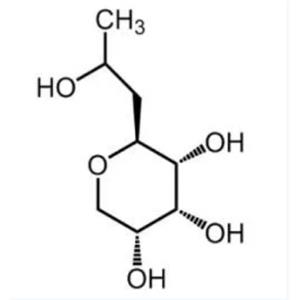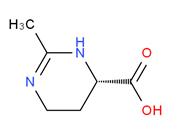1/1
Pro-xylane NEW
- Min. Order1kg
- Purity99%
- Cas No868156-46-1
- Supply Ability10mt
- Update time2024-11-27

| Product Name | Pro-xylane |
| CAS No | 868156-46-1 |
| EC-No | |
| Min. Order | 1kg |
| Purity | 99% |
| Supply Ability | 10mt |
| Release date | 2024/11/27 |
Pro-xylane
Product Name:( S)-Pro-xylane
Cas No.: 868156-46-1
INCI : HYDROXYPROPYL TETRAHYDROPYRANTRIOL
Appearance : White powder
Molecular Formula :C8H16O5
Molecular Weight :192.21
Brand:SACH
Minimum:1
Standard:99%
Unit:kg
Pack:25kgs/drum
Melting Point:376.0±42.0°C
Density:1.368±0.06 g/cm3
Solubility:DMSO: 250 mg/mL (1300.66 mM)
Introduction
Pro-xylane, also known as Hydroxypropyl Tetrahydropyranthriol, Pro-xylane is a biologically active C-glycoside in aqueous media that can be used as a biosynthetic activator for glycosaminoglycans (GAGs). Pro xylane is the first "green" chemical substance used in cosmetics. For a pair of non corresponding isomers, the structure is as follows:

The importance of β - glycosidic bonds in maintaining the biological activity of Pro-xylane is much greater than that of α - glycosidic bonds. At the same time, the different stereoconfigurations of the hydroxyl position (7th chiral carbon) in the glycosidic ligand (hydroxypropane) lead to different proportions of diastereomers, which exhibit different biological activities. In the comparative study of biological activities with different proportions of diastereomers, it is believed that the biological activity of dr=70/30 is greater than that of dr=50/50. Based on research literature and patents, the following preliminary conclusions can be drawn: the higher the proportion of (β, S) configuration in the compound, the better the biological activity.
Function
Polysaccharides play a crucial role in embedding and maintaining the dermal matrix structure of collagen fiber networks. Recent studies have shown that aging human skin contains less gag than younger skin, leading to differences in their mechanical properties. These considerations propose a new concept of potential skin anti-aging molecules that can help maintain matrix structure by stimulating the synthesis of GAGs and PGs, proteoglycans (PGs), and glycosaminoglycans (GAGs).
Pro-xylane is a xylose derivative with anti-aging activity, which can promote the synthesis of collagen, make the skin stronger and more elastic, improve neck fine lines, and prevent aging. Bose is a mixture of glycoproteins derived from xylose. Due to the abundant presence of xylose in oak trees and its ability to promote the production of glycosaminoglycans, namely glycosaminoglycans (GAGs). As a pro-xylane extracted from oak trees, its function is similar to that of xylose.
1. Help the skin absorb the active ingredients in cosmetics
Pro-xylane is a type of ether, belonging to a non-ionic surfactant with significant dispersing and emulsifying abilities. It can help other active ingredients enter the skin like ethanol and be absorbed by the skin.
2. Promote the synthesis of glycosaminoglycans
Pro-xylane is a mixture of propylene glycol and water, and is one of the many derivatives of xylose that can affect the secretion of glycosaminoglycan (GAG). GAG is one of the components of the human extracellular matrix, with strong hydrophilicity, which can help maintain moisture in loose connective tissue, promote wound healing, and have significant moisturizing effects. Pro-xylane can indirectly increase the production of collagen in the dermis by promoting the synthesis of glycosaminoglycans, thereby promoting dermal repair, improving skin elasticity, and increasing skin firmness. It can increase the water content between extracellular matrix by stimulating the generation of glycosaminoglycan GAGs. Thus fully filling the gaps in ECM, reducing wrinkles and making the skin appear more delicate.
3. DEJ Activation: Enhancing Skin Elasticity and Firmness
Simultaneously acting at the DEJ site, promoting the synthesis of collagen VII and collagen IV, making our epidermis and dermis more tightly connected, resulting in the entire skin appearing fuller, firmer, and more elastic.
4. Promote cell migration and have a repairing effect on the skin
Overall, Pro-xylane can promote dermal repair, improve skin elasticity, reduce wrinkles, and increase skin firmness, thus playing an anti-aging role in the skin. At the same time, it can hydrate, moisturize, improve skin elasticity, tighten, reduce wrinkles, and repair.
Application
1. Wound healing
In scratch tests conducted on a 2D keratinocyte culture model, it was shown that Pro-xylane can promote the migration and proliferation of fibroblast growth factor-10 dependent keratinocytes, thus possessing the ability to promote wound healing. This mechanism of action has been further confirmed in clinical studies.
Ten volunteers' arms were treated with negative pressure suction to create wounds of equal area for epidermal peeling, which were used as experimental and control sites, respectively. Apply 2mg/cm2 of cream containing 10% bose on the test site twice a day, and apply placebo cream without bose on the control site in the same way, observe and take photos every day to record the wound healing. After 7 days, compared with the placebo part, the wound area of the part using Boseline containing cream was reduced, and the degree of healing was significantly improved .
2. Skin anti-aging
In a randomized, placebo-controlled clinical study involving 41 healthy female volunteers (aged 45-65 years), the subjects used a 2mg/cm2 half face cream containing 3% bose twice a day and a placebo cream half face for 6 months. Compared with the placebo cream, the subjects observed the improvement of skin wrinkles, elasticity, gloss and other skin aging related indicators (clinical score+instrument evaluation). Compared with the placebo control half face, after one month of using Pro-xylane cream, it was observed that the skin color was significantly more uniform; After 3 months of use, skin elasticity improves; After 6 months of use, it can be seen that the number of pores has decreased and the skin quality has further improved.
In another randomized, placebo-controlled clinical study involving 88 healthy female volunteers (aged 60 to 75 years), one group of subjects (44 cases) used 2mg/cm2 cream containing 10% bose twice a day for full face, and the other group of subjects (44 cases) used placebo cream for 6 months. Compared with the placebo control group, the skin of volunteers in the Bose Einstein group showed significant overall improvement, including reduced wrinkles, increased elasticity, and increased skin radiance.
Improving dynamic pattern research
In a clinical study involving 43 Chinese female volunteers (aged 20-50), a high-speed imaging system was used to record the skin changes of volunteers during dynamic facial expressions by overlaying multiple high-speed cameras and optimizing the shooting angle and lighting environment. Multiple frames of images were captured continuously in one second, and the changes were analyzed using software algorithms and clinical scoring. Volunteers used the Pro-xylane product twice a day with a full face area of 2mg/cm2 for 4 weeks, and compared it with before use. The improvement effect on dynamic and static wrinkles was evaluated through clinical scoring, instrument measurement, and subject self-assessment. After 4 weeks, compared with before use, the Pro-xylane product significantly reduced dynamic wrinkles (Figure 6), and showed significant improvements in traditional skin aging detection indicators such as static wrinkles (12 types of wrinkles, with improvement levels greater than 20%).
Company Profile Introduction
SACH BIOTECH Co.,Ltd. was reorganized and established in 2023, formerly known as Hangzhou Shitai Biotech Co.,Ltd. The main body of the company is located by the beautiful West Lake of Hangzhou. The main production base is located in Shandong Province, China, and the pilot production base and laboratory are located in Henan province. After 15 years of hard work and accumulation, we now have a strong research and development team and experimental equipment, and the pilot plant can meet the requirements of different customers. The production base located in Shandong, China can meet the needs of customers for industrial scale production.



